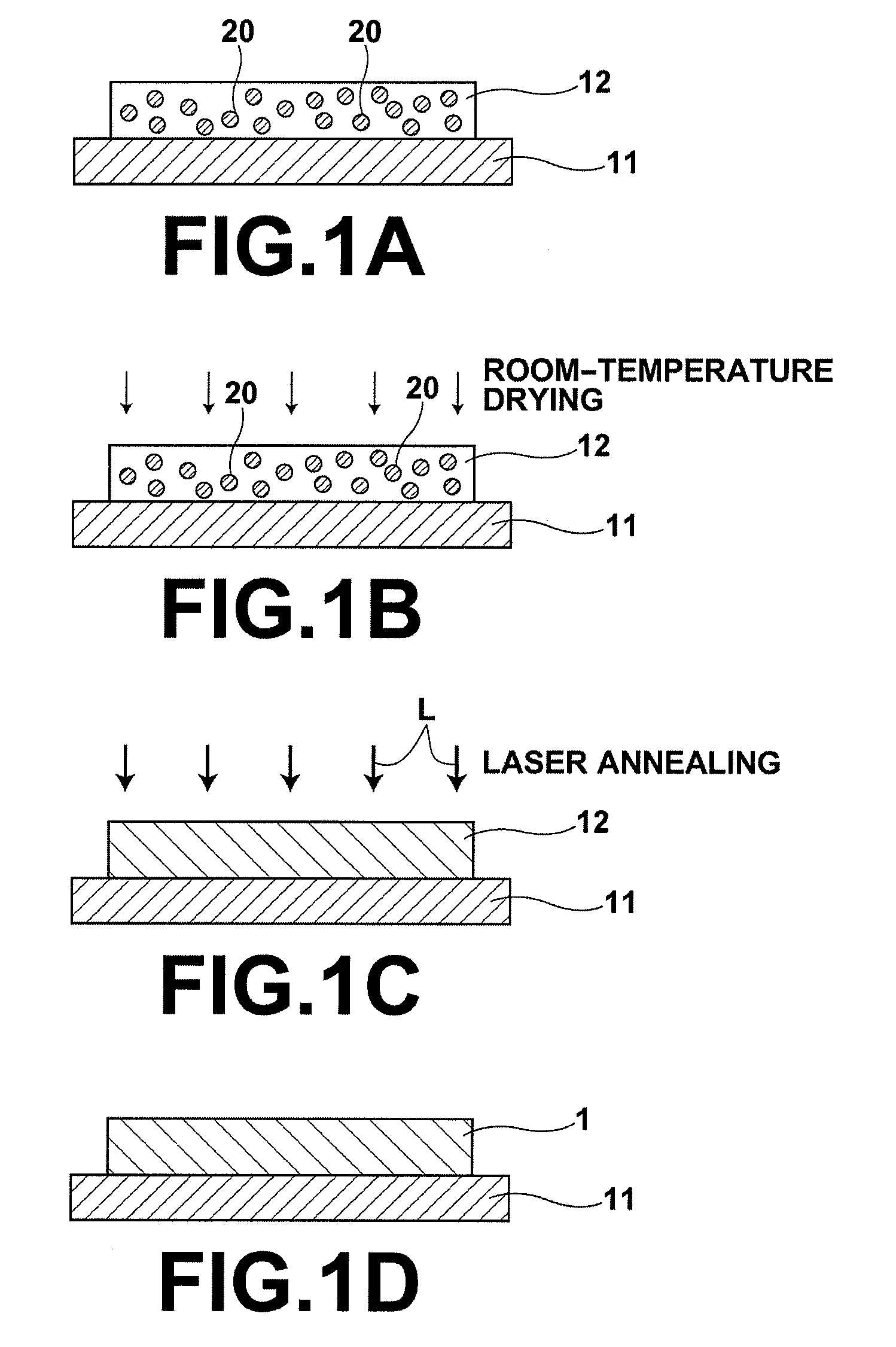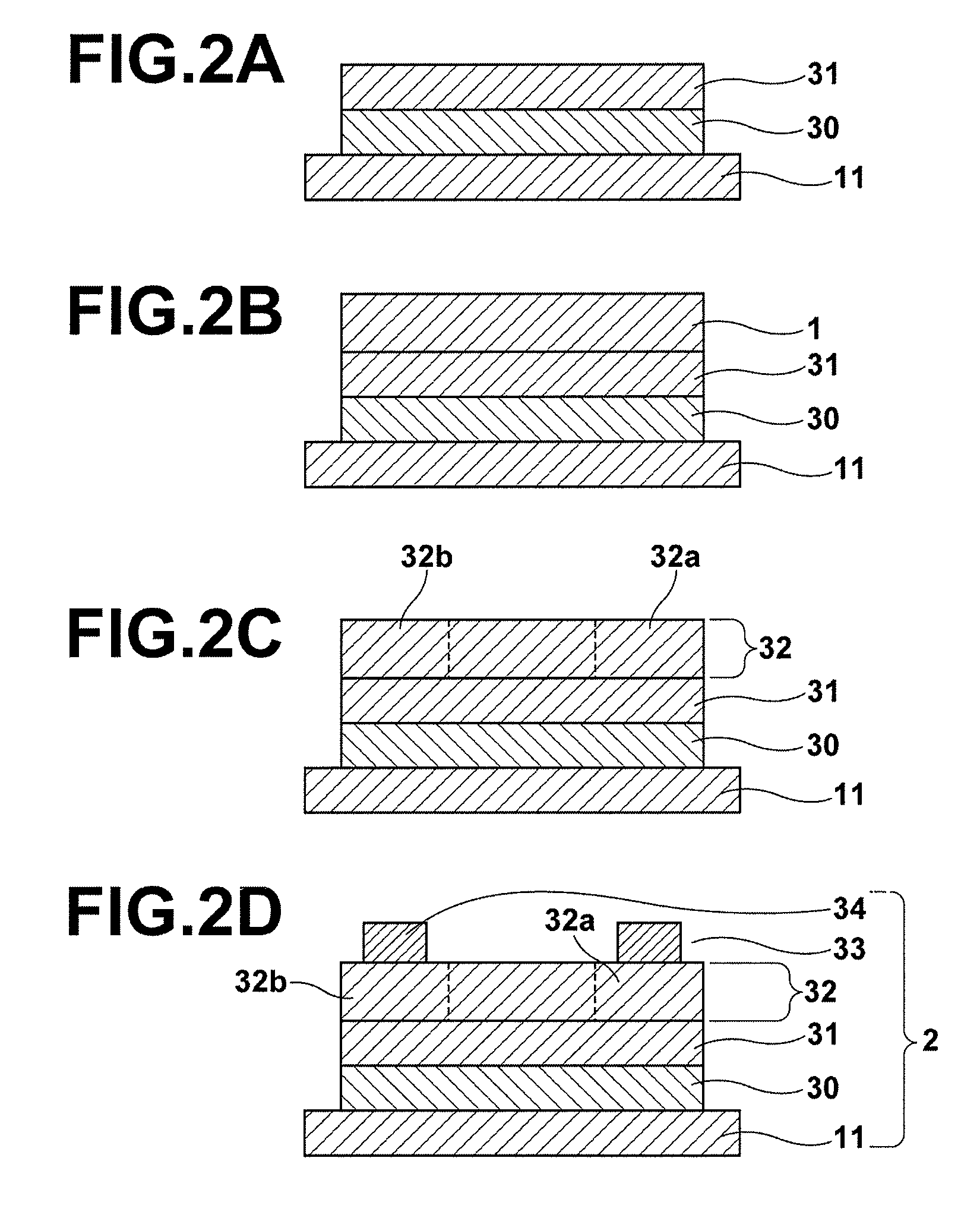Process for producing oriented inorganic crystalline film, and semiconductor device using the oriented inorganic crystalline film
a technology of inorganic crystalline film and oriented inorganic crystalline film, which is applied in the direction of non-metal conductors, conductors, and gel states, can solve the problems of high equipment cost, use the technique disclosed, and waste of considerable amounts of materials, etc., and achieves low cost, low-cost manufacturing, and superior element characteristics.
- Summary
- Abstract
- Description
- Claims
- Application Information
AI Technical Summary
Benefits of technology
Problems solved by technology
Method used
Image
Examples
example 1
4.1 Concrete Example 1
[0084]The concrete example 1 of the oriented inorganic crystalline film according to the present invention has been produced as follows.
[0085]First, a film of ZnxGayInzO(x+3y / 2+3z / 2−d) (which is hereinafter referred to as IGZO) has been formed by using crystalline nanoparticles of IGZO, which have been produced by a sol-gel process, where x, y, and z are real numbers greater than zero, and satisfy the relationship,
0≦d≦(x+3y / 2+3z / 2) / 10.
[0086]A raw-material solution to be applied to a substrate has been prepared as follows. A solution having a light-yellow color (hereinafter referred to as the solution A) has been prepared by mixing 2.2 g of zinc acetate dihydrate, 2.47 g of gallium isopropoxide, and 2.74 g of indium isopropoxide into cyclohexanol and stirring the mixture at 150° C. The relative composition (the ratio between molar fractions) In:Ga:Zn of the solution B has been measured as 1.08:1:1 by ICP (inductively coupled plasma) spectroscopy. Then, a solutio...
example 2
4.4 Concrete Example 2
[0096]The concrete example 2 of the oriented inorganic (IGZO) crystalline film according to the present invention is different from the concrete example 1 in that the non-monocrystalline film has been crystallized by laser annealing. In the laser annealing, the non-monocrystalline film has been irradiated with the KrF excimer laser light having the wavelength of 248 nm, the laser irradiation power has been controlled by use of an attenuator, and the number of laser shots has been 200. The most superior crystallinity has been obtained when the laser irradiation power is 103 mJ / cm2.
[0097]The IGZO film crystallized as above has been analyzed by XRD. The greatest X-ray diffraction intensity has been observed at the diffraction angle 2θ of 30.8 degrees, which corresponds to the (009) face, and the normalized X-ray diffraction peak intensity at the diffraction angle 2θ of 55.7 degrees corresponding to the (110) face (i.e., the I value) of the crystallized non-monocry...
example 3
4.5 Concrete Example 3
[0099]The concrete example 3 of the oriented inorganic (IGZO) crystalline film according to the present invention is different from the concrete example 1 in that the solution B is prepared by heating and stirring the solution A at 230° C. (instead of 250° C.) for an hour, and the non-monocrystalline film has been crystallized by laser annealing with the KrF excimer laser light (as the concrete example 2).
[0100]The solution B prepared as above has a russet color. After the solution B has been prepared, the relative composition (the ratio between molar fractions) In:Ga:Zn has been measured as 1.05:1:1, and the average diameter of the crystalline nanoparticles dispersed in the solution B has been measured to be approximately 5 nm.
[0101]Thereafter, a non-monocrystalline IGZO film has been formed in a similar manner to the concrete example 1, and crystallized by laser annealing in a similar manner to the concrete example 2. Specifically, the non-monocrystalline fil...
PUM
| Property | Measurement | Unit |
|---|---|---|
| thickness | aaaaa | aaaaa |
| thermal-resistance temperature | aaaaa | aaaaa |
| thermal-resistance temperatures | aaaaa | aaaaa |
Abstract
Description
Claims
Application Information
 Login to View More
Login to View More - R&D
- Intellectual Property
- Life Sciences
- Materials
- Tech Scout
- Unparalleled Data Quality
- Higher Quality Content
- 60% Fewer Hallucinations
Browse by: Latest US Patents, China's latest patents, Technical Efficacy Thesaurus, Application Domain, Technology Topic, Popular Technical Reports.
© 2025 PatSnap. All rights reserved.Legal|Privacy policy|Modern Slavery Act Transparency Statement|Sitemap|About US| Contact US: help@patsnap.com


